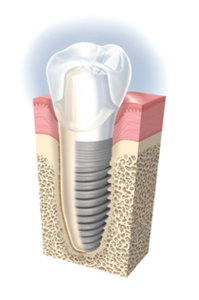Pre-implant Surgery
Pre-implant analysis
The placement of dental implants requires a thorough preparation, carried out before the operation with the help of examinations such as X-rays, scans, etc.
The placement of a dental implant can be exposed to the problem of insufficient bone capital in some patients.
In order to guarantee an effective anchorage and durability for the future prosthesis, dental implants must be placed in sufficient bone volume.
When the bone volume is too small, it can be surgically increased by a bone graft or bone filling. The grafted bone can either come from the patient: this is the autograft, generally taken from the lower jaw; or from a biomaterial: this is a graft without removal.
A preliminary bone assessment is imperative to define the technique, the volume of bone to be reconstructed and whether or not dental implants should be placed simultaneously.
Bone grafting will only be performed as a last resort, if the shortest dental implants cannot be used. In fact, the latest scientific and technological advances make it possible to avoid or reduce the use of bone grafts in most cases.
Pre-implant bone grafting
Generally speaking, there are two types of bone grafts:
Autografts : the bone is taken from the person receiving the graft, most often in the lower jaw, either on the chin or on the sides. We will be able to recover a small block of bone that will be stabilized with the help of a minivis. This type of graft is called an apposition graft or onlay graft. A period of 6 to 8 months of healing is usually required for the graft to integrate. Then the dental implants can be placed and the fixation screws usually removed at the same time. This type of bone grafting can be used to treat extensive bone loss in height and thickness under local anesthesia. For patients with very significant bone loss who require larger grafts, bone can be harvested from the skull or hip. These grafts are the responsibility of maxillofacial surgery. They are performed under general anesthesia in a hospital.
Non-transplantation” grafts : in this situation, the bone defect is filled with different biomaterials of synthetic, human or animal origin. In all cases, these materials undergo a series of sanitary treatments that guarantee a very high level of safety in their use. The graft is placed in the area where the lack of bone is a problem. Once immobilized, it will gradually guide new bone formation. This type of bone filling can be associated with the simultaneous or deferred placement of dental implants. A healing period of 4 to 9 months is necessary for optimal consolidation of the graft. This bone filling allows to compensate for small defects and the lack of bone volume in the sinuses: it is the sinus graft or sinus lift.
Pre-implant surgery – Sinus lift – Bone filling
In the posterior region, in the upper jaw, in edentulous areas, there is often an increase in sinus volume (posterior cavity) at the expense of the bone crest.
There are two possible scenarios:
Either the height of the crest is at least 6 mm and short dental implants can be placed with a real success rate.
Or the height of the ridge is less than 6 mm: it is then necessary to increase the volume of the bone ridge at the expense of the sinus, to position dental implants with a more common length (13mm).
The sinus surgery and the placement of dental implants are performed in the same session, so that the patient does not have to undergo pre-medication, post-operative consequences and two surgeries twice.


